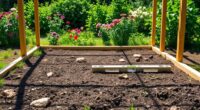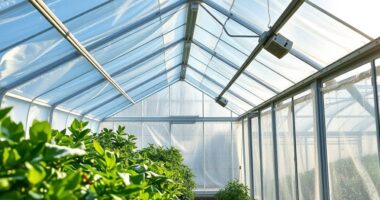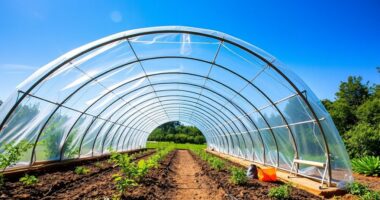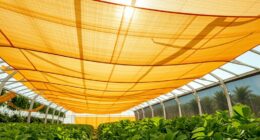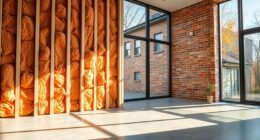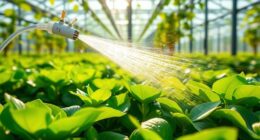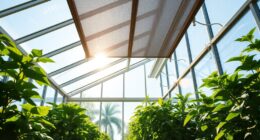To construct a greenhouse, you need essential tools like trowels, drills, and safety gear. Frame materials such as galvanized steel or aluminum offer durability, while polycarbonate or glass serves as effective covering options. For foundations, consider concrete or gravel for stability. Inside, create designated zones and use shelving to maximize space. Don’t forget ventilation and lighting for optimal growth. If you want to explore more tips and materials for a successful greenhouse, keep going!
Key Takeaways
- Essential hand tools include trowels, scoops, and pruning tools for effective construction and plant maintenance.
- Power tools like drills and saws are necessary for assembly, while fastening tools ensure structural security.
- Safety gear such as safety glasses and work gloves is crucial for protection during the construction process.
- Choose frame materials like galvanized steel or aluminum for durability, and consider covering options like polycarbonate for insulation.
- A solid foundation, using materials like concrete or gravel, enhances stability and drainage in greenhouse construction.
Essential Tools for Greenhouse Construction

When building a greenhouse, having the right tools at your disposal can make all the difference.
You’ll want essential hand tools like trowels for digging and scoops for transferring potting soil. Pruning tools, such as hand pruners and snips, will help with plant maintenance. Don’t forget knives for cutting string and rakes for soil smoothing.
Power tools are equally important; drills and saws are must-haves for assembly. Fastening tools, including screws and bolts, ensure everything stays secure.
Safety gear like safety glasses and work gloves protects you during construction. Finally, measuring tapes and levels help you achieve accurate results.
Additionally, investing in backyard greenhouse materials can enhance the durability and efficiency of your structure.
With these tools in hand, you’ll be well-equipped to create your greenhouse.
Frame Materials for Greenhouses
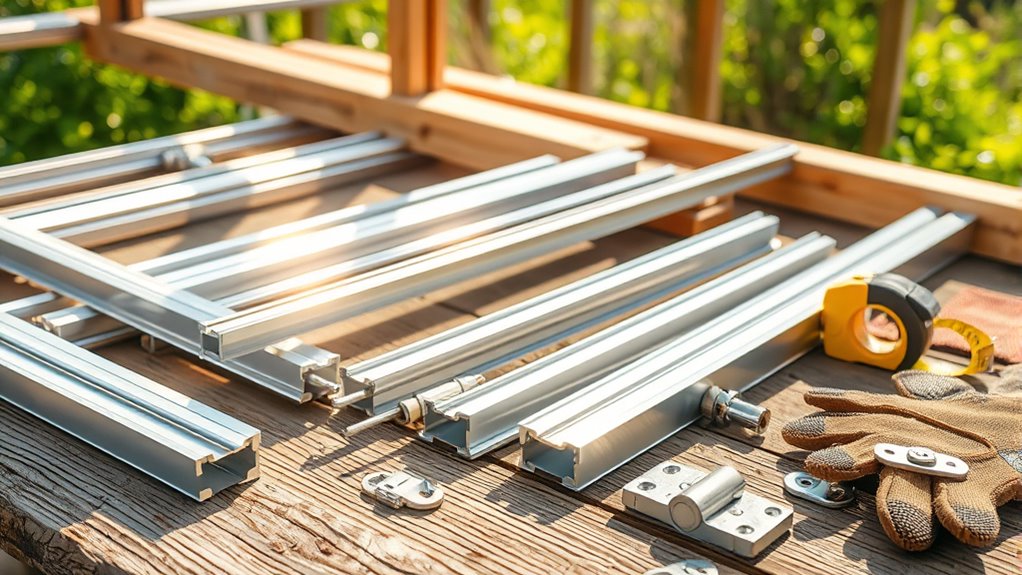
Building your greenhouse involves not just the right tools but also selecting the appropriate frame materials. You can choose from several options, each with its pros and cons.
Galvanized steel offers strength and durability, perfect for harsher climates, while aluminum is lightweight and corrosion-resistant, making it great for DIY projects.
If you prefer a natural look, wood provides aesthetic appeal but requires more maintenance. For smaller structures, PVC is affordable and easy to work with, though less durable.
Composite materials blend the benefits of wood and plastic, offering low maintenance.
Consider your budget, climate, and desired aesthetics to select the best frame material for your greenhouse needs.
Covering Materials for Greenhouses
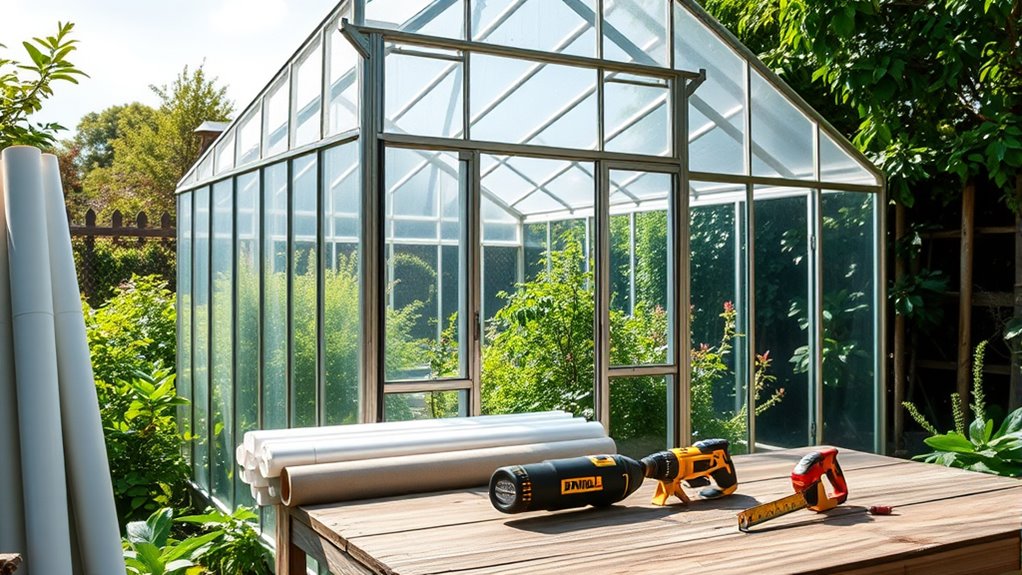
Choosing the right covering material for your greenhouse is crucial, as it directly impacts insulation, light transmission, and overall durability.
Options like polycarbonate offer excellent insulation and are shatterproof, while Solexx provides durability and light diffusion, making it ideal for cold climates.
Polycarbonate ensures superb insulation and shatter resistance, while Solexx excels in durability and light diffusion for colder environments.
If you’re looking for a budget-friendly choice, poly film is easy to install but requires frequent replacement.
Glass, though aesthetically pleasing and high in light transmission, is more expensive and needs careful installation.
Acrylic shares some benefits with polycarbonate but is less durable.
Consider the climate and your specific needs when selecting a covering material to ensure your greenhouse thrives year-round.
Regular maintenance, like cleaning, is essential for maximizing light transmission and longevity.
Foundation Materials for Greenhouses
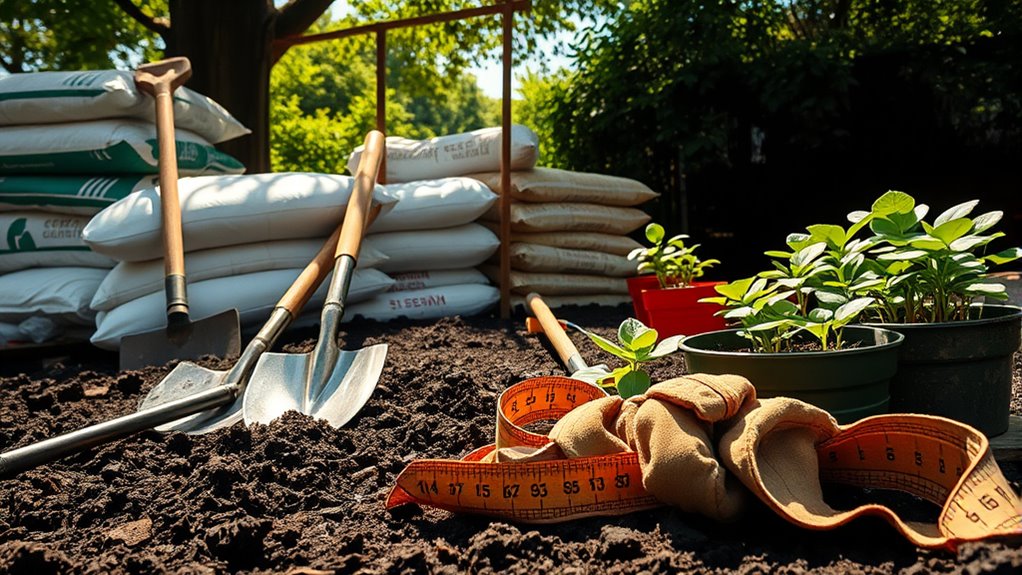
Selecting the right foundation material for your greenhouse is essential, as it sets the stage for stability and longevity.
Concrete is a solid choice for permanent structures, offering durability and low maintenance. If you prefer aesthetics and ease of use, wood might be your go-to, especially for hobby greenhouses.
Bricks or cinder blocks provide a stable base but require a flat surface. For improved drainage, consider gravel or crushed stone, which is cost-effective.
While soil is the cheapest option, it poses risks like flooding and pests.
Think about your climate, budget, and whether you want a permanent or movable structure to choose the best foundation material for your greenhouse needs.
Internal Layout and Accessories

Creating an effective internal layout for your greenhouse is crucial for maximizing both plant growth and your workflow. Start by designating specific zones for different plant types, ensuring tailored care.
Efficient space utilization is key; consider tiered shelving to maximize vertical space while keeping the floor clear. Ensure wide paths for easy access and maintenance, promoting airflow to reduce mold risk.
Maximize vertical space with tiered shelving while keeping pathways clear for easy access and improved airflow.
Incorporate potting benches near entrances to streamline your work process. Utilize under-bench storage for supplies and use pegboards to keep tools organized.
For ventilation, consider natural and forced options to maintain ideal climate conditions. Lastly, ensure proper light distribution through strategic placement of plants and supplemental lighting during low-light periods.
Specialized Equipment for Advanced Greenhouses

When you invest in specialized equipment for advanced greenhouses, you’re setting the stage for optimal plant growth and efficiency.
Temperature management systems with sensors ensure perfect climate control, while humidity systems keep moisture levels just right. Carbon dioxide injectors enhance photosynthesis, boosting plant vitality. Shade curtains regulate light and temperature, and effective ventilation systems prevent overheating.
Advanced lighting systems, like energy-efficient LED grow lights, cater to specific plant needs.
Hydroponic and aquaponic systems provide precise nutrient and water delivery, promoting growth. Automation and monitoring technology allows you to control climate and irrigation remotely.
Safety Considerations During Construction
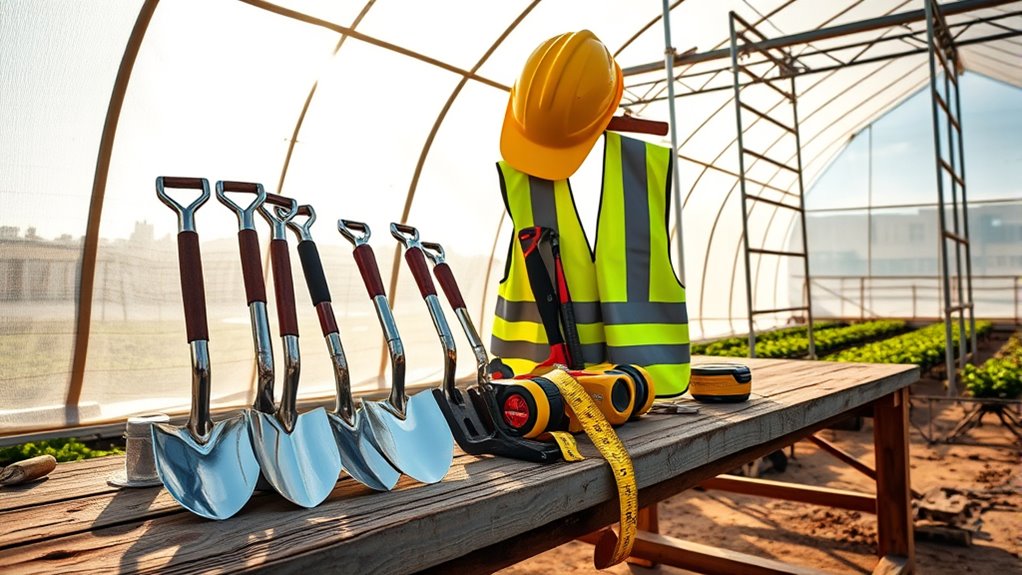
Ensuring safety during greenhouse construction is crucial, as it protects workers and enhances the integrity of the structure. Start by complying with local zoning regulations and securing necessary permits.
Safety in greenhouse construction is vital for worker protection and structural integrity; ensure compliance with zoning regulations and obtain necessary permits.
Establish a budget that includes safety measures, and choose a well-drained site that maximizes sunlight. Equip workers with personal protective equipment (PPE) like closed-toe shoes and safety glasses.
Prioritize electrical safety by using GFI-protected outlets and keeping cords dry. Ensure the greenhouse frame can withstand environmental loads, and install fire extinguishers while following propane heater guidelines.
Handle hazardous materials carefully, adhering to safety protocols. Finally, develop emergency plans for natural disasters to safeguard everyone involved in the construction process. Additionally, consider integrating portable power solutions to ensure consistent energy supply during construction activities.
Maintenance Tips for Greenhouses

To keep your greenhouse thriving, regular maintenance is essential. Start by cleaning the interior and exterior to prevent disease and pests.
Ensure proper ventilation by inspecting and cleaning fans, vents, and louvers. Check your irrigation system for leaks and clogs to maintain efficient watering. Use shade cloths or paints to protect your plants from excessive sunlight. Regularly inspect the structure for any damage or wear.
For climate control, automate ventilation and maintain cooling and heating systems. Regularly disinfect surfaces to manage pests and diseases. Additionally, consider extending your gardening season by using your greenhouse effectively during colder months.
Implement integrated pest management and biocontrols, while removing debris promptly. Lastly, inspect your irrigation system frequently to ensure it’s working properly and that your water quality is suitable for optimal plant growth.
Frequently Asked Questions
What Is the Best Location for a Greenhouse?
When choosing the best location for your greenhouse, prioritize areas that receive at least six hours of direct sunlight daily.
Position it with the longest side facing south to maximize light.
Ensure it’s on level ground with good drainage and easy access to water and electricity.
Consider nearby structures for shade during hot months and evaluate local wind patterns to protect against strong gusts.
Always check local regulations before finalizing your site.
How Much Sunlight Does a Greenhouse Need?
Your greenhouse needs a good amount of sunlight to thrive. Aim for 12 to 16 hours of light daily during the growing season.
Most plants flourish with light intensity between 10,000 to 20,000 lux, but some may require even more.
Consider your plants’ specific needs—full sun lovers like tomatoes need at least 6 to 8 hours, while shade-loving varieties can get by with just 2 to 4 hours.
Adjust your setup accordingly!
What Is the Ideal Size for a Greenhouse?
When figuring out the ideal size for your greenhouse, consider your available space, budget, and gardening goals.
If you’re a hobbyist, a small greenhouse (6×8 ft) might be perfect. For serious gardening, a medium size (8×12 ft) offers versatility.
If you plan to grow commercially, opt for a large greenhouse (12×18 ft or more).
Always think about the types of plants you want to grow and how much space they’ll need to thrive.
Can I Build a Greenhouse on a Slope?
Building a greenhouse on a slope can be a fun challenge! You can absolutely do it, but you’ll need to consider a few things.
First, think about drainage—ensure water flows away to avoid soggy soil. You might also want to create flat terraces with retaining walls to prevent erosion.
Just remember to orient the greenhouse southward for optimal sunlight, and you’ll have a thriving space in no time!
How Do I Prevent Pests in My Greenhouse?
To prevent pests in your greenhouse, start by installing insect screens on vents and doors.
Maintain cleanliness by regularly removing debris and weeds.
Manage water carefully to avoid excess moisture that attracts pests.
Consider introducing beneficial insects like ladybugs and using sticky traps for monitoring.
Rotate crops and ensure proper plant spacing for airflow.
Finally, isolate new plants to prevent pests from entering your greenhouse.
Regularly scout for any emerging infestations.
Conclusion
In the world of greenhouse construction, having the right tools and materials can make all the difference. By laying a solid foundation and choosing the best covering and frame materials, you set yourself up for success. Don’t forget about safety and maintenance, as they’re key to keeping your greenhouse thriving. So, roll up your sleeves and dive in—building a greenhouse is a rewarding venture that’ll pay off in more ways than one!

